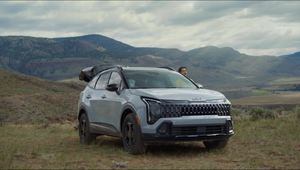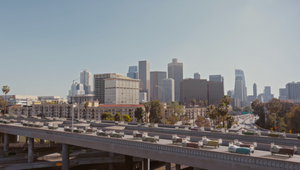
How Kia Is Aiming to Fill this Summer's Movie Void with an Action Packed Feature Demonstration Film

Among the many changes to life that Covid-19 has generated is a lack of opportunity to go to the cinema and a lack of new films to see even if a trip to the movies was possible. Kia Motors America didn't need to be this way. The brand, along with its agency David & Goliath, has launched 'The Feature Film', an innovative action short film which seamlessly strings together a sequence of 13 high-octane, 15-second videos, with one of Kia’s automotive features coming to the rescue in each episode.
A who’s-who of Kia’s A-list automotive talent shared lead actor duties in the film. Making cameo appearances throughout the movie are all manner of vehicle features that you'll need to keep your eyes peeled for. The smart thing is that this project is essentially a feature demonstration, a form of advertising that can so easily be tediously dull but with the right approach is anything but.
LBB's Addison Capper spoke with Chris Mead, associate creative director / copywriter, and Kris Wong, associate creative director / art director, to find out more.
LBB> What was the initial brief for this campaign and what were your initial thoughts when you saw it?
Chris and Kris> The initial brief was to do a series of demonstration videos for safety and tech features like Lane Keep Assist. Our first thought was, ‘oh no’. But right away we started thinking about the opportunity to do something really unique and unexpected that would subvert typical safety demos. Brands have to do that kind of hard-working stuff all the time, but it doesn’t have to be boring. And we’re lucky to work with an agency and a group of clients at Kia that shares that mindset.
LBB> How did that brief end up as an epic action short film?
Chris and Kris> It started with the idea that these safety demos could be narratively connected somehow. And since the product is a range of fun, fast cars that naturally led us to the action genre pretty quickly. We thought if we could make feature demos into an exciting action film, we might entice people to spend more time watching, and learning about the brand. Or at the very least, think ‘that was kinda cool’.
LBB> How much of it is inspired by our lack of ability to go to the cinema at the moment?
Chris and Kris> This project has been a long time in the making, and we began filming when the word “coronavirus” was just a blip on the radar. But that has obviously changed, and our strategy department and clients deserve a lot of credit for waiting to release this at the right time, when we might be able to fill a little bit of that entertainment void that people are missing right now.
LBB> When it came to writing this film, where did you look for inspiration? And how did you find the experience of writing what is essentially a short action movie, as opposed to a more traditional ad?
Chris and Kris> We only had to look as far as some of our favorite neo-noirs and action films, such as Drive, John Wick, Blade Runner, the Bourne series, and Michael Mann films like Heat and Collateral, to name a few. The short action movie format is a bit deceptive, since the larger story is built out of a series of connected 15-second episodes. But crafting that larger story was a welcome opportunity to flex a different storytelling muscle. It allowed us to create something a little more intricate and maybe a little grittier, with more room to breathe than the usual :30 might allow.
LBB> How did you go about writing each different Kia feature into the script without it becoming annoying for the viewer?
Chris and Kris> We knew that communicating the features was the entire purpose, so there was no hiding from them. With that in mind, we really tried to embrace them and make each one the defining moment of its episode. That allowed us to build the story around what each feature does, so they feel like they’re integral and driving the action rather than jammed in. We always looked at the features as the real stars of the film.
LBB> On top of being a flowing short film, it's actually a selection of short films that all piece together to form one coherent story. That's a feat in itself! How did you pull that off and how did it impact the writing process?
Chris and Kris> Early in the process, we zeroed in on this story of a driver trying to escape a life of crime, and the organisation determined to stop him. From there, we used the various features to help us create action and story beats to build the rest of the narrative. It was definitely a puzzle, but very rewarding once everything fit together.
LBB> From a production standpoint, when did you begin work on this? And how did you pull off under current restrictions?
Chris and Kris> We shot in mid-February and finished editing in early March. Fortunately, we were able to complete production before we had to quarantine. Most of our post-production had to be done remotely, but we were working with top-of-the-line veteran houses like The Mill and Lime, and they made it so the process didn’t skip a beat.
LBB> Why was the team at Slice the right crew to pull this off?
Chris and Kris> We’ve been in love with Ozan’s work for a long time. He’s a great filmmaker, but he’s also a car buff through and through, and that passion absolutely comes through in his work. But on top of that, he’s a great collaborator. And he and his team at Slice went above and beyond in their preparation and execution. This project was a beast, no way around it. Lots of locations, lots of stunt driving, lots of tricky dialogue, lots of night shoots, lots of fight choreography… and five nights to capture 14 episodes. It was enough to make a line producer’s head explode. But they sold us on their backyard of Vancouver, worked a few miracles of location scouting, and brought in some top-notch talent for the crew. They planned for every eventuality and never allowed anything to catch us off guard. They were great partners and we always felt like our production was in good hands.
LBB> What were the trickiest components and how did you overcome them?
Chris and Kris> It’s not an exaggeration to say that every step of the process had its own set of hurdles. There were many times when it seemed like this project would not happen. And the only reason it ever saw the light of day was because of an insanely dedicated and tenacious team of people that never gave up. Everyone at D&G - our producer Genevieve Shah, our account team, our creative leadership (John O’Hea, Steve Clarke and Mark Koelfgen) and even agency founder David Angelo himself - they all fought tooth and nail to get this made. Our clients at Kia always believed in this idea and were champions for it, despite how seemingly risky and out-there it was, and they went all-in to make it happen. And our production partners at Slice, who so clearly saw our vision and set the stage for Ozan to work his magic. A lot of people believed in this project and put themselves on the line to make it happen. And for that we are incredibly grateful.















